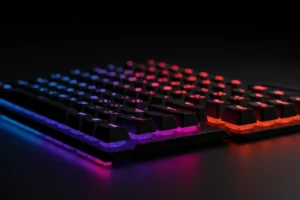So, how do you understand the safety of keyboards with fingerprint scanners? As a keyboard enthusiast and someone deeply immersed in the world of typing devices, I’ve been closely observing the integration of biometric features into our everyday peripherals.
The fusion of fingerprint scanners with keyboards is a fascinating development, promising enhanced security and convenience. But the pressing question remains: Are they truly safe? Let’s see this topic right now.
🔐 Understanding Fingerprint Scanners on Keyboards
Fingerprint scanners have become ubiquitous in smartphones and laptops, offering a quick and secure way to unlock devices. Their integration into keyboards is a natural progression, aiming to provide users with seamless authentication methods.
By embedding fingerprint sensors into keyboards, manufacturers aim to streamline the login process, reduce reliance on passwords, and enhance overall user experience.
However, with convenience comes the responsibility of ensuring that these biometric systems are secure. The primary concern revolves around the storage and protection of fingerprint data.
If not adequately safeguarded, this sensitive information could be vulnerable to breaches, leading to potential identity theft or unauthorized access.
Moreover, the reliability of fingerprint scanners can vary based on the technology used.
Factors such as sensor quality, software algorithms, and environmental conditions can influence the accuracy and speed of fingerprint recognition. It’s essential to understand these nuances to make an informed decision about using such keyboards.
For a deeper insight into the evolution of keyboard technologies, you might find this article on The Future of Foldable and Flexible Keyboards enlightening.

🛡️ Security Concerns: Are They Justified?
While fingerprint scanners offer a layer of security, they are not impervious to threats. Researchers have demonstrated that fingerprint sensors can be spoofed using advanced techniques.
For instance, a study highlighted in Wired showcased how 3D-printed fingerprints could deceive certain biometric systems.WIRED
This revelation underscores the importance of not solely relying on fingerprint authentication, especially for high-security applications. It’s advisable to use multi-factor authentication methods, combining biometrics with passwords or security tokens, to bolster protection.
Furthermore, the software managing these fingerprint scanners plays a pivotal role in ensuring security. Regular updates, patches, and adherence to security protocols are essential to mitigate potential vulnerabilities
. Users should ensure that their devices receive timely software updates and that manufacturers have a track record of addressing security concerns promptly.
🧠 Advantages of Fingerprint-Enabled Keyboards
Despite the security concerns, fingerprint-enabled keyboards offer several benefits:
- Convenience: Quickly log in without typing passwords.
- Enhanced Security: Biometric data is unique, reducing the risk of unauthorized access.
- Streamlined Workflow: Ideal for professionals who require frequent logins.
- Integration with Security Protocols: Can be combined with other security measures for robust protection.
For professionals who prioritize both security and efficiency, these keyboards can be a valuable addition to their setup. However, it’s crucial to remain vigilant and informed about potential risks.

🔍 Notable Fingerprint Keyboard Models
Several reputable brands have ventured into producing keyboards with integrated fingerprint scanners. Here are some noteworthy models:
- Microsoft Modern Keyboard with Fingerprint ID: Combines sleek design with Windows Hello integration.
- Lenovo ThinkPad TrackPoint Keyboard II: Offers the classic ThinkPad experience with added biometric security.
- HP USB Fingerprint Keyboard: Designed for enterprise environments, ensuring secure logins.
- Dell KB813 Smartcard Keyboard with Fingerprint Reader: Combines smart card and fingerprint authentication for enhanced security.
- BIO-key SideTouch USB Fingerprint Reader Keyboard: A versatile option compatible with various systems.
When selecting a fingerprint-enabled keyboard, consider factors like compatibility, ergonomic design, and the manufacturer’s commitment to security updates.
📊 Comparative Overview
To aid in decision-making, here’s a comparative table highlighting key features of the mentioned models:
| Model | Integration | Design | Target Audience |
|---|---|---|---|
| Microsoft Modern Keyboard with Fingerprint ID | Windows Hello | Sleek, minimalist | General users |
| Lenovo ThinkPad TrackPoint Keyboard II | Windows Hello | Classic ThinkPad | Professionals |
| HP USB Fingerprint Keyboard | Enterprise-grade | Standard layout | Businesses |
| Dell KB813 Smartcard Keyboard | Dual-auth | Durable build | Enterprises |
| BIO-key SideTouch USB Fingerprint Reader | Versatile | Compact | General users |

🤔 Final Thoughts
Incorporating fingerprint scanners into keyboards is a testament to the evolving landscape of user authentication. While they offer undeniable convenience and a layer of security, it’s imperative to remain aware of potential vulnerabilities. By staying informed and adopting best practices, users can harness the benefits while mitigating risks.
If you found this article insightful, please consider sharing it and leaving a comment below. Your feedback helps us delve deeper into topics that matter to you.
See More
- 10 Essential Accessories For Keyboard
- 10 Weirdest Keyboards Ever Made
- The Best RGB Lighting on Keyboards
📚 Further Reading
- The Future of Foldable and Flexible Keyboards
- How to Choose the Best Keyboard for Your Needs
- [The Best Keyboards with Adjustable Actuation Points](https://tecladostecno.com/the-best-keyboards-with-adjustable-actuation
🎮 Join Our Discord Community!
Are you passionate about keyboards, gaming, and tech? Come hang out with fellow enthusiasts, ask questions, share your setup, and stay updated with our latest content!
👉 Join Now

